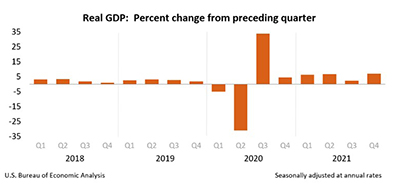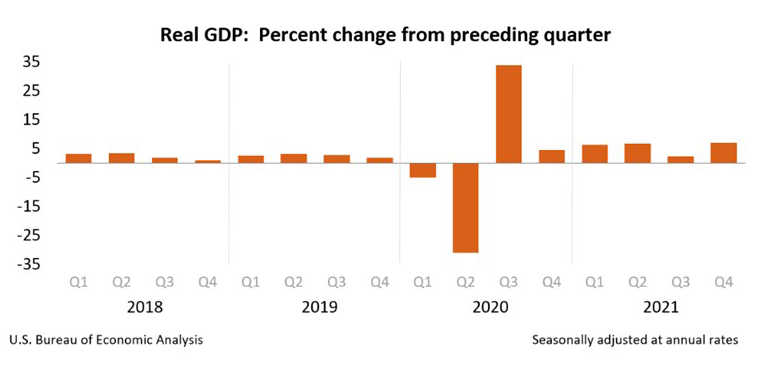
4Q GDP Zips Along at 7% Clip; 2021 GDP Grew by 5.7%

U.S. gross domestic product continued to move along at a brisk clip in the fourth quarter, according to the second (revised) estimate issued Thursday by the Bureau of Economic Analysis.
For all of 2021, BEA said GDP increased by 5.7 percent, compared to 3.4 percent decrease in 2020.

The report said real gross domestic product increased at an annual rate of 7.0 percent in the fourth quarter. In the third quarter, real GDP increased by 2.3 percent. BEA said the revised estimate is based on more complete source data than were available for the “advance” estimate issued last month. In the advance estimate, the increase in real GDP was 6.9 percent. The updated estimates primarily reflected upward revisions to nonresidential fixed investment, state and local government spending, and residential fixed investment that were partly offset by downward revisions to personal consumption expenditures and exports.
BEA said the increase in real GDP primarily reflected increases in private inventory investment, exports, PCE and nonresidential fixed investment, partly offset by decreases in both federal and state and local government spending. Imports, a subtraction in the calculation of GDP, increased.
The increase in private inventory investment was led by retail and wholesale trade industries. Within retail, inventory investment by motor vehicle dealers was the leading contributor. The increase in exports reflected increases in both goods and services. The increase in exports of goods was widespread, and the leading contributors were consumer goods, foods, feeds, and beverages, as well as industrial supplies and materials. The increase in exports of services was led by travel. The increase in PCE primarily reflected an increase in services, led by health care, financial services and insurance, and transportation. The increase in nonresidential fixed investment primarily reflected an increase in intellectual property products that was partly offset by a decrease in structures.
The decrease in federal government spending primarily reflected a decrease in defense spending on intermediate goods and services. The decrease in state and local government spending reflected a decrease in gross investment (led by new educational structures). The increase in imports primarily reflected an increase in goods (led by non-food and non-automotive consumer goods, as well as capital goods).
Separately, BEA said real GDP increased by 5.7 percent, unchanged from the prior estimate, in 2021 compared to a decrease of 3.4 percent in 2020 (table 1). The increase in real GDP in 2021 reflected increases in all major components, led by PCE, nonresidential fixed investment, exports, residential fixed investment and private inventory investment. Imports increased.
Current-dollar GDP increased by 10.1 percent (revised), or $2.10 trillion, in 2021 to $23, compared to to a decrease of 2.2 percent, or $478.9 billion, in 2020.
